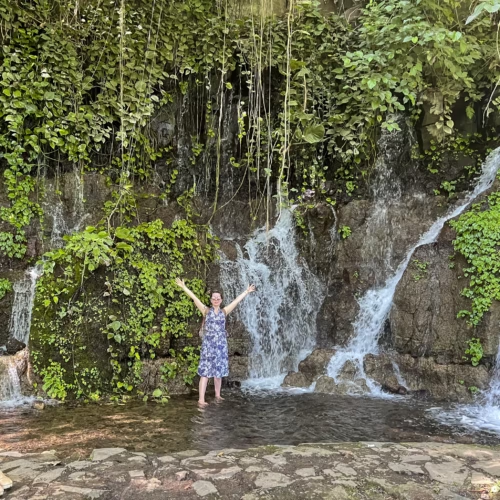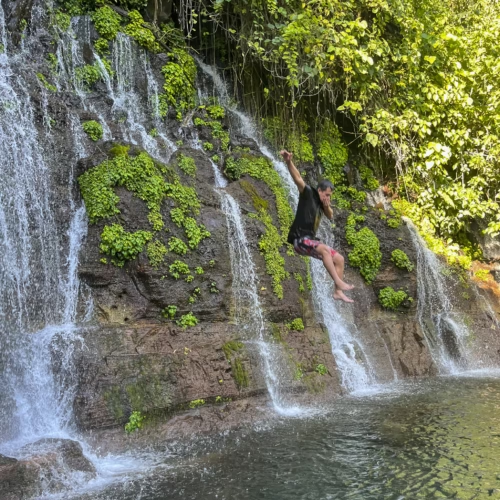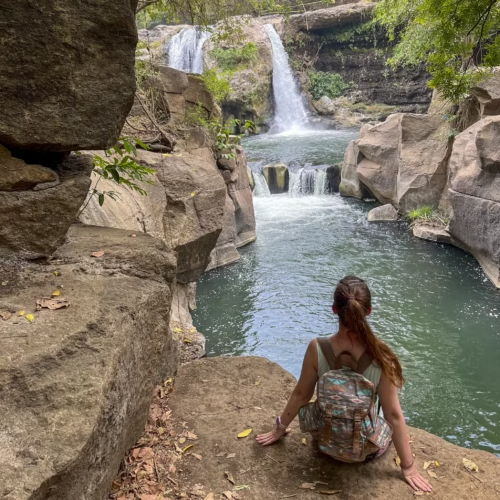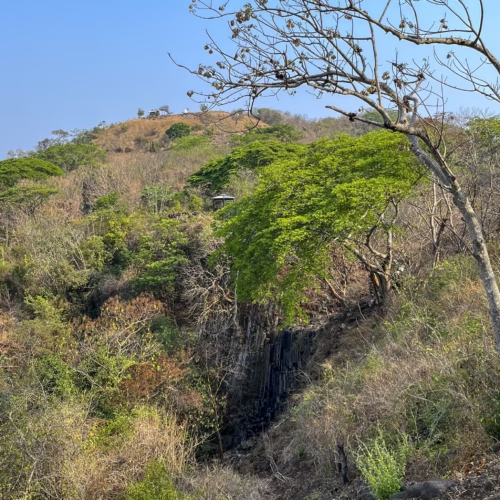I want to tell you about three breathtaking waterfall in El Salvador, which offer a blend of natural beauty and adventure: Chorros de la Calera, El Salto de Malacatiupán and the Cascadas Los Tercios.
Chorros de la Calera waterfall in El Salvador
I spent one week in El Salvador and we rented a car. The public transportation is slower and you are a bit limited. You can use Uber, but it would cost more. So, the most efficient was to hire a car for a week. If you would like to go by bus, you shall take bus number 205 from San Salvador to Sonsonate, and bus number 249 from Sonsonate to Juayúa.
If you stay in San Salvador to reach Juayúa by car you shall take the Panamerican highway westward. When you reach Sonsonate turn right towards Nahuizalco. It takes about one and a half hours to get there. Juayúa is part of the Ruta de las Flores trail.
About the waterfall
The Chorros de la Calera waterfall is located in the municipality of Juayúa in the department of Sonsonate, in the southwestern part of El Salvador. It is one of the most well-known natural wonders which features a series of beautiful waterfalls and natural pools in the municipality. The waterfall is 2 km from the village of Juayúa to the east.
We left Juayúa and got to a dirt road, which was in a bad condition. Two Salvadorian guy came across and we asked them if we are on the right path. They told us, that yes, this dirt road leads to the waterfall. However, there is no entrance fee, tourists maybe are charged for the trip, only locals can enter free of charge. And maybe we also have to pay for parking. The guys also told us, that maybe we have to hire a guide to enter, as well.
But they had time and they were happy to show us the way. Fortunately, we were at the beginning of the dirt road, we rolled back and parked the car at the very beginning of the dirt road. The guys came with us and they were our guides along the whole route. They were very kind and helpful. The Salvadorians are generally kind and hospitable people.
The hike to the waterfall
We hiked from the last house in Juayúa to the waterfalls and enjoyed the scenic route. Please note, that in the rainy season the dirt road can be muddy and slippery. At the end of the dirt road we reached the first waterfall and the pool, which wasn’t too deep.
Natural jets of water emerge from the rock walls, creating beautiful waterfalls fed by springs higher up on the mountain. This is where the name of the waterfall is originated. Another characteristic of the place, thanks to its unique topography, is that the path ends at Chorros de la Calera. Here you are greeted by the deafening echo of the falling water from the first waterfall. This waterfall is perhaps the most spectacular, with its free fall of approximately 100 meters. Its crystalline water plunge into the ravine and crashing onto the massive forested rocks below.
We spent a bit of time here by the first waterfall and then we continued our way forward. We walked a bit in the forest and then reached the second waterfall and pool. This pool was deeper, you also can swim in it. And you can jump from the cliffs to the pool, as well. Get ready that you surely will be wet, even if you don’t swim. We spent about two hours here, but you can easily spend more time here.
It is said that behind the waterfalls there is a cavern. In order to find the cavern, you must swim to the big rock in the middle of the pool and dive a bit. You can find a small pool in the cavern. I don’t know if it is true, we didn’t check it.
We hiked our way back in the forest across the mountain and got back to the dirt road.
The climate of the place is pleasant in every month of the year, due to the dense vegetation and soil moisture. In the jungle you can see a lot of coffee bushes. We admired the local flora and enjoyed the different natural springs that forms the pools and waterfalls along the way.
Salto de Malacatiupán waterfall in El Salvador
The Salto de Malacatiupán is one of the most important natural resources in the west and one of the most beautiful. You have to visit it.
It is a hot spring waterfall, located in the western part of the country, in the municipality of Atiquizaya, department of Ahuachapán. Atiquizaya has around 28 water springs and the name of the municipality means “Place abundant in water” or “place of springs” in Nahuat. Nahuat was spoken before the Spanish colonisation in several parts of Central America.
The word Malacatiupán means “Round Temple” in Nahuat. According to the legends, the ancestors, the ethnic group of “Pocomames” who lived in the area, performed rituals in this place. Nowadays the locals call it “jump”, because the waterfalls are high and they allow you to perform acrobatic jumps. That’s where the name “Salto de Malacatiupán” came from.
How to get to the waterfall?
The Salto de Malacatiupán is located around 98 km from the capital city of San Salvador. To get there from San Salvador by car, you have to drive towards Santa Ana. From there head towards Atiquizaya. From Atiquizaya follow local roads to the waterfall, it is approximately 5 km from there.
If you travel by public transport you can choose between bus route 202 that travels from San Salvador. Or bus routes 210 and 214 that travel from Santa Ana. All routes go through Atiquizaya and stops at the central park, where you shall get off. You can hire a tuk-tuk there to bring you to the waterfall, it should not cost you more than $6 USD.
Or you can search for a travel agency that offers a tourist guide and everything necessary for you to enjoy the experience. You can ask about guides in hostels or contact the Atiquizaya mayor’s office to help you.
When you get to the waterfall
The Agua Caliente River has hot springs, and at the point of its birth the temperature of the water is around 70 degrees. This temperature is too high and it’s not possible to bathe in the river there. Under the El Viejo bridge two rivers, the Agua Caliente River and the cold Quiroz River intertwine. If you follow this river link, you will come across the Malacatiupán Falls. The Salto de Malacatiupán is the only waterfall in El Salvador with hot water. The temperature of the water is between 30 and 35 degrees. The color of the water is turquoise.
The entrance fee is $1.50 USD per pax. If you go with a vehicle you have to pay for parking: $2 USD per car and $1 USD per motorcycle.
After you enter, you walk down a narrow path and then you can cross the streams on tiny wooden bridges. Go left. After you turned left, on the right side you will find some stairs that will take you down to the waterfalls and pools. You can bathe in the pools, enjoy the natural spa, but beware, the water is quite hot!
The waterfall is approximately 12 meters high. One of the other peculiarities is that the second and third waterfalls are divided by a huge rock, the appearance of which resembles the face of a monkey.
If you continue your way up, moving away from the waterfalls, the creek becomes much more quiet. I sat down on one of the rocks and put my feet into the water. Suddenly, some little fish came and started to eat the dead skin from my feet. I got a little pedicure, it was truly a spa day!
Recommendations for visiting the Salto de Malacatiupán waterfall
Bring your own food and drinks. Bring enough water since the temperature in Malacatiupán is usually hot, and be sure to drink enough water to hydrate yourself. You can find a restaurant next to the waterfalls, but better be prepared.
Be careful with the pools. Relaxing in the hot springs of Malacatiupán is ideal, however, be aware before getting into the waters. There are pools with more depth and these are usually dangerous. You should also be careful about entering just below where the water falls.
Bring your own trash container. You can take care of the place if you bring your own trash away with you. Carry a bag or any other container to throw your garbage into and you can take it away, not to leave any rubbish there.
Salto de Malacatiupán provides visitors a warm and relaxing experience, it’s a heavenly place surrounded by abundant vegetation and cliffs.




Cascadas los Tercios waterfall in El Salvador
The Los Tercios waterfall is in the municipality of Suchitoto, in the department of Cuscatlán. It is located 1 km from Suchitoto’s city center, on the road that leads to the municipality of Cinquera, in the department of Cabañas.
The peculiarity of the 10 meter tall waterfall is the hexagonal shape of its basalt rocks, as if they had been carved and arranged on purpose and appear to have been made by hand. This waterfall is unique and mysterious, according to locals and the owners of the area it has its origin of a curse and a failed love.
The legend says that the daughter of a rich family in the area fell in love with an indigenous man, and her parents made that love impossible. Because of this, the young man’s father placed a curse on the family. The family had a fabric warehouse, the curse caused the rolls of fabric to turn into stone and they lost everything. Since then the stones of the waterfall are that hex shaped.
Although, there is also another story known in the town that tells that in the depths of the pool lives a little goldfish. In winter, the goldfish gives life to the waterfall, but whoever sees it cannot tell it, otherwise he ends up chaotic or dead.
When is the best time to visit the Los Tercios waterfall?
The waterfall is one of the favourite places of tourists in Suchitoto mainly in the rainy season. Only when it rains can you fully appreciate the waterfall, because in the rest of the year it remains dry.
I visited the waterfall in the dry season, it wasn’t wet at all, there wasn’t any droplet of water in the waterfall. In spite of this, even in the dry season it is worth the visit, because of the unforgettable views of Lake Suchitlán and the beautiful landscapes, vegetation and fauna. You can find three viewpoints in the area, rest areas with hammocks among trees and a pleasant climate.
However, be aware that maybe you can meet snakes and scorpios on your way and near the waterfall. During our visit in Suchitoto, one of the tourist office worker told us some stories how she and her friends ended up scorpios and snakes around their head and body. (Or maybe she just wanted to scare us!)
The place is open to the public every day, from 8:30 am to 5:30 pm, and the entrance fee is $1 USD per person and they ask $1.00 USD for parking. If you go by bus, you shall take bus number 129 from San Salvador to Suchitoto.
Exploring these waterfalls in El Salvador provides a glimpse into the country’s natural splendor and offers memorable experiences for travelers. If hiking to the waterfalls exhausts you, this blog post will show you places where you should stop for a bite.
Estimated reading time: 9 minutes




What i don’t understood is actually how you’re not actually much more well-liked than you may be right now. You’re so intelligent. You realize therefore significantly relating to this subject, produced me personally consider it from a lot of varied angles. Its like women and men aren’t fascinated unless it is one thing to do with Lady gaga! Your own stuffs outstanding. Always maintain it up!
Hi! Thank you for your kind words! Everybody has to start somewhere, and build things up 🙂